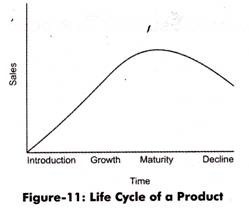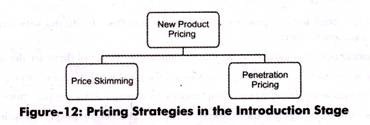A product processes through a number of stages, such as from introduction to growth, maturity, and decline.
This sequence of stages is called Product Life Cycle (PLC). The PLC influences the marketing strategy and marketing mix of an organization.
Figure- 11 shows the stages involved in PLC:

Stages of Product Life Cycle
The different stages of PLC (as shown in Figure-11) are explained as follows:
ADVERTISEMENTS:
i. Introduction:
Refers to the initial stage where an organization creates awareness among customers about the availability of a product and develops a market for the new product. The sales of the organization during this period are constant. In this stage, the pricing policy depends upon the availability of dose substitutes. Moreover, in this stage, the prices are either fixed higher to cover the production cost or low to attract customers.
Figure-12 shows strategies that are used in the introduction stage of a product:
The two types of pricing strategies in the introduction stage (as shown in Figure-12) are explained as follows:
ii. Price Skimming:
Refers to a pricing strategy in which a producer sets high prices initially when the product is newly introduced in the market. After that, there is a gradual reduction in the prices of a product. This strategy is used to capture maximum consumer surplus and spread profits over a period of time.
iii. Penetration Pricing:
ADVERTISEMENTS:
Refers to charging minimum price for a product for gaining large market share. In this strategy, it is expected that customers switch to the product because of lower price.
The main benefits of penetration pricing are as follows:
a. Discourage the entry of competitors as low prices do not suit them
b. Results in the fast adoption of products
c. The limitations of penetration pricing are as follows:
1. Raises the expectations of customers that the prices will remain low for a long period
2. Creates a low-profit margin that makes it difficult for the organization to survive
When the objective of penetration pricing is achieved, the price of the product is increased.
iv. Growth Stage:
ADVERTISEMENTS:
Implies a stage where the focus of the organization is on lowering the cost of production. At this stage, there are various substitutes of products available in the market leading to competition. The product is exported to other countries to gain economies of scale and market share.
v. Maturity Stage:
Refers to the longest stage in the product life cycle. In the maturity stage, the growth in the sale of the product slows down because the price competition increases in the foreign markets. As a result of this, the organizations shift their manufacturing facilities to the countries where the cost of labor is low to reduce cost of production.
In this stage, the organizations that loose the market share exit from the industry. In the maturity stage, the promotion plays a great role in increasing the product sale. In such a situation, organizations should try to explore the new uses of the product.
ADVERTISEMENTS:
vi. Decline Stage:
Implies a stage in which the growth of the product in the market is declining at a fast pace. In this stage, sales and profits of the organization decrease because of new products and technologies are introduced in the market. A product produced by an organization may have different stages in different countries at the same time. For example, a product may face growth stage in one country and decline stage in another country. In such a situation, loses in one country’ can be covered by the profits earned in another country.
